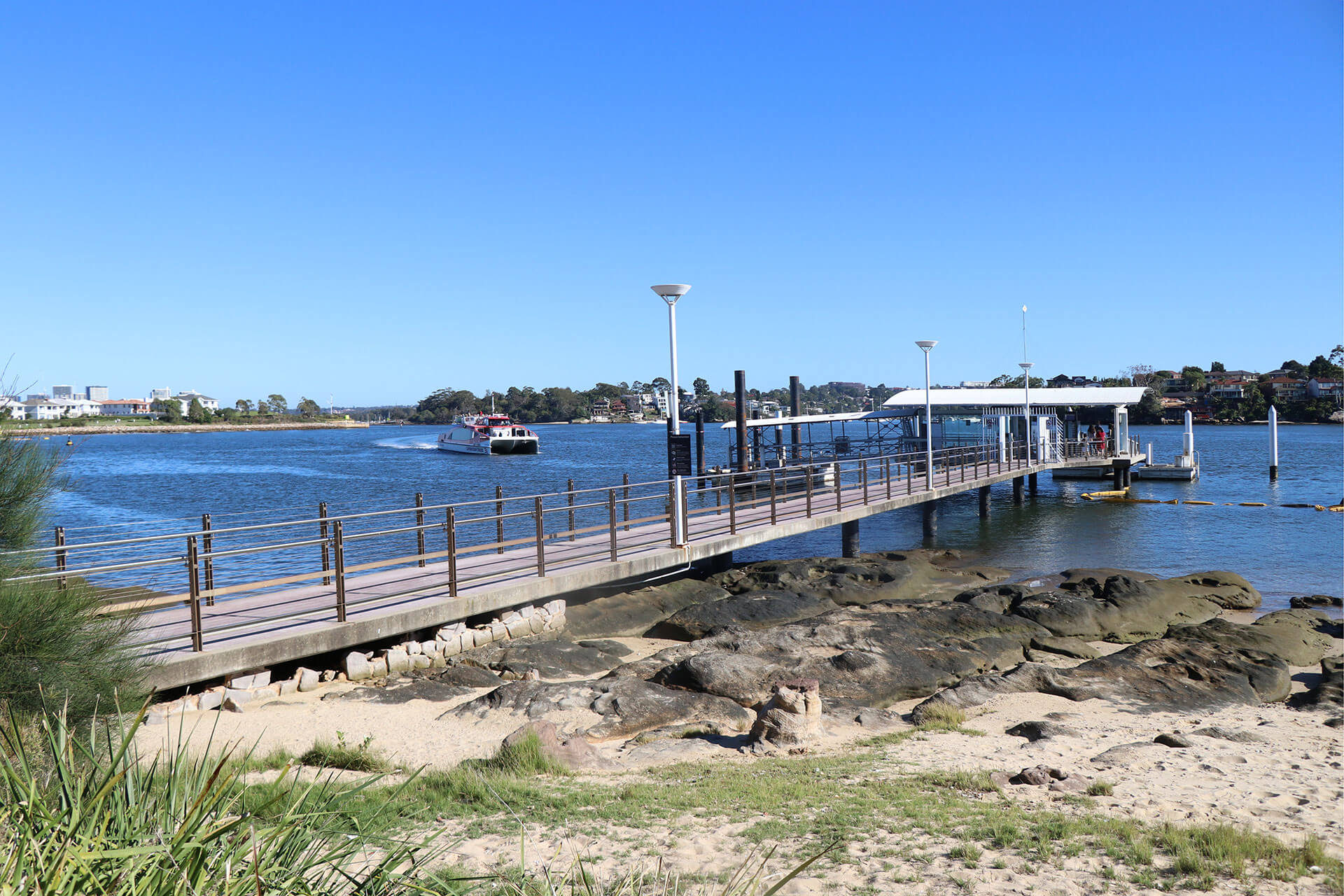Living rivers around the world
There is a global movement to make city rivers the centres of life they once were. Many cities around the world, including Berlin, Copenhagen and Texas, have turned their rivers into public swimming and recreational sites – proof that our mission for the Parramatta River can be achieved. Check out the following examples of living rivers that showcase the best in design and innovation.
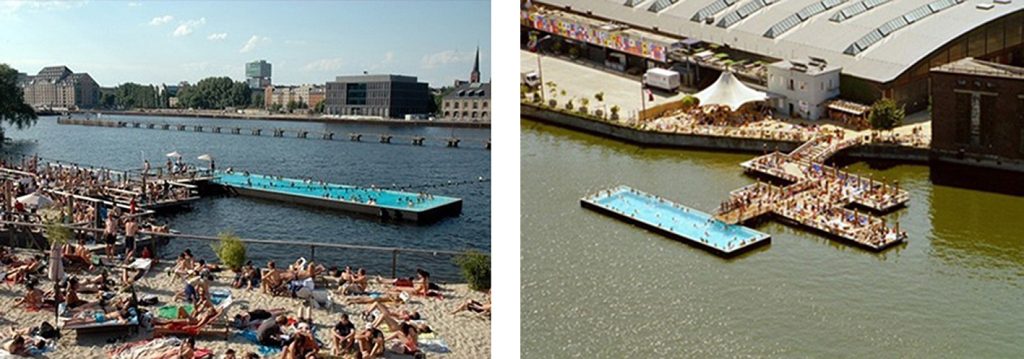
The Badeschiff (bathing ship) floats on the River Spree in Germany, providing a recreational swimming facility amongst a medium density residential and commercial area in the city of Berlin. The pool provides a sanitary place to swim using chlorinated fresh water, alongside a river where water quality is unsafe for human swimming.
Opened in 2004 as a project organised by the City Art project Society, the Badeschiff can house up to 1500 visitors at a time and has a full range of facilities including toilets, hot showers, lifeguards, a sandy beach and deck chair sunbathing area, open air bars and sheltered saunas in winter when the weather becomes too cold for outdoor swimming. It also plays host to a range of entertainment activities including music events and parties.
Providing connections to the natural river and environment, the Badeschiff has become a cultural icon in the city, successfully activating the waters edge and surrounds and creating a new space for urban recreation.
Images: www.amusingplanet.com

Nlands Surf Park is a man-made, recreational surfing park created in Austin, Texas. Featuring a large lagoon with simulated waves, the facility is 45 times larger than an Olympic-sized swimming pool. In addition to bringing surfing and swimming facilities to the area, which is surrounded by farmland and open space, the park uses a unique rainwater catchment system to ensure it preserves the region’s precious water resources.
Rainwater is channeled to a wet pond and bio-filtered by algae and fish before it moves to a deep reservoir and through a filtration system for treatment. Even in the most challenging drought conditions known to the region, NLand’s lagoon is self-sustaining year-round.
NLands Surf Park has activated an area unlikely and unreached for surfing, leisure and water activities, while employing a practical and environmentally sustainable method to maintain the water park.
Read more about the NLands Surf Park.
Images: NLand Surf Park & www.surfermag.com
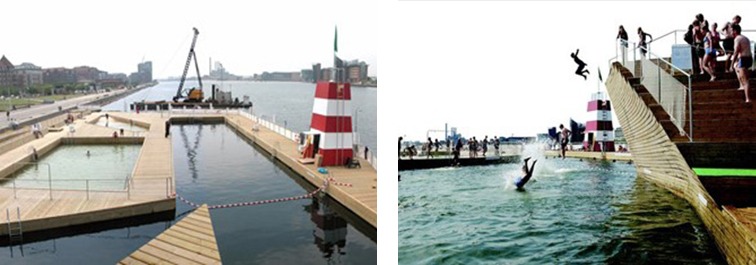
The Harbour Baths are a system of recreational swimming and bathing facilities along Copenhagen’s waterfront using natural river water. For many years, the discharge of wastewater from sewers and industrial companies resulted in pollution of Copenhagen harbour. Municipal investment and dedication to improving the sewage system saw to the closing of 55 overflow channels and development of rainwater reservoirs. This major overhaul and modernisation of the sewage system has effectively improved the water quality, elevating it to a level that is safe for human contact. In 2002, the first swimming bath was opened in the area of Islands Brygge.
Located at the heart of Copenhagen, the Baths have transformed an industrial port area into a thriving location for leisure, exercise and social activities in a prominent location. The Baths have created defined entry points to the river, making public access an ease, and are designed with formal boundaries to replicate swimming pools. With four bathing locations along the waterfront (total 2500 square metres) all using natural river water, they include a full range of facilities and interactive areas such as dry-docks, boat ramps, playgrounds and pontoons.
Water quality levels are checked daily to ensure they are safe for swimming. An established on-line warning system calculates and monitors the water quality in the harbour. If the water quality is poor, the swimming facilities are immediately closed.
Read more about how Copenhagen municipality restored and cleaned up their river.
Images: www.archdaily.com.
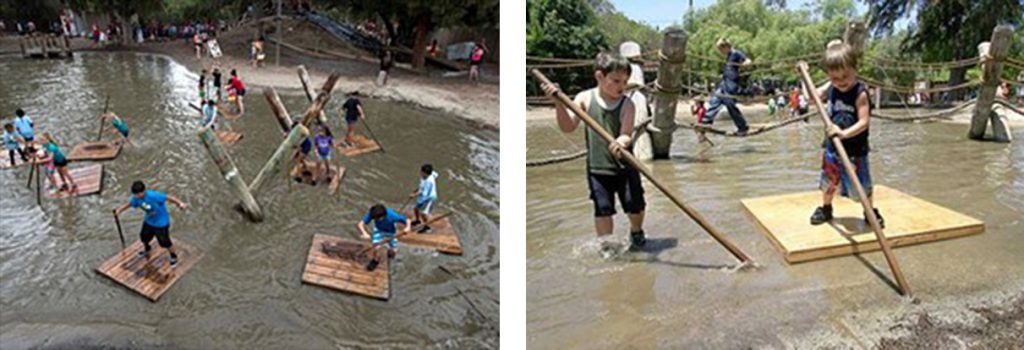
The Adventure Playground in Huntington Beach Central Park is a man-made, freshwater pond with various activities and props to encourage children’s water play. This includes floating islands, rafts, slides and rope bridges amongst others for splash contact. The water level is not deep enough for swimming but provides entertainment and a place to cool down.
The Adventure Playground is located in the popular local park which has strong community visitation. It provides a unique element of water play in the natural park setting, providing different interactive activities to the public space in addition to the cycle paths and picnic facilities already present.
Images: Orange County Register.
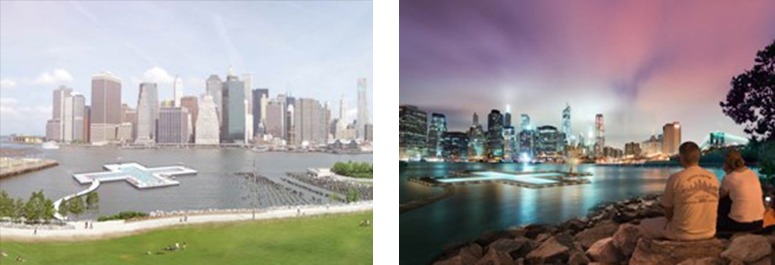
+ Pool is a proposal for the design and installation of a floating pool in the centre of New York City, allowing swimming in natural water where the river is currently too polluted for recreational use. + Pool will float on the Manhattan and Brooklyn banks of the East River, containing water filtration systems in its perimeter walls to treat river water for contaminants, bacteria and odours and effectively allow swimming in natural river water. Working like a huge strainer placed into the river, + Pool will have the capacity to clean up to half a millions gallons of water each day.
+ Pool will have four recreational spaces serving different audiences and needs; a kid’s pool, Sports pool, Lap pool and Lounge pool.
Currently raising funds and support through a Kickstarter campaign, + Pool has already received over $350,000 in crowd-funding from citizens, residents and businesses of New York.
Learn more and watch the progress of +Pool.
Images: +Pool & The Huffington Post.
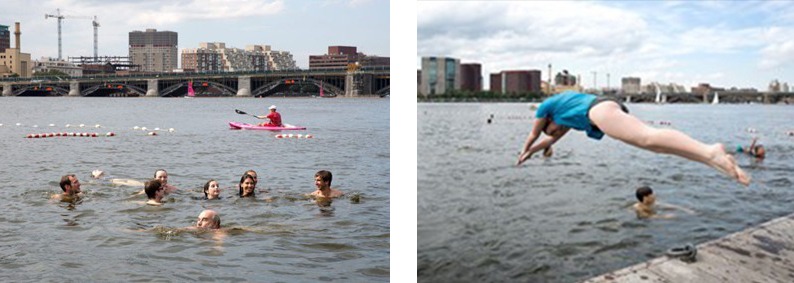
Similar to our Parramatta River, swimming in the Charles River was once a favourite summer pastime for many residents in and around Boston. In the mid-1950’s, a growing awareness of the river’s pollution and the possible health risks it posed forced the closure of riverfront beaches along the Charles.
The potential for public swimming in the Charles River exists today as a result of a number of federal and state initiatives, including the 1972 amendments to the Clean Water Act and 50 years of hard work by the Charles River Watershed Association, a devoted advocate to water quality in the Charles.
In 2013, water quality in the river was upgraded to an A-, making it the healthiest urban river in the United States. Community swimming events held since then have demonstrated sizable public interest in swimming in the river again.
The Charles River is currently raising funding to undertake the necessary tests and measures required to open the river for safe public swimming again.
Learn more about the Charles River.
Images: The Charles River Conservancy & www.wbur.org
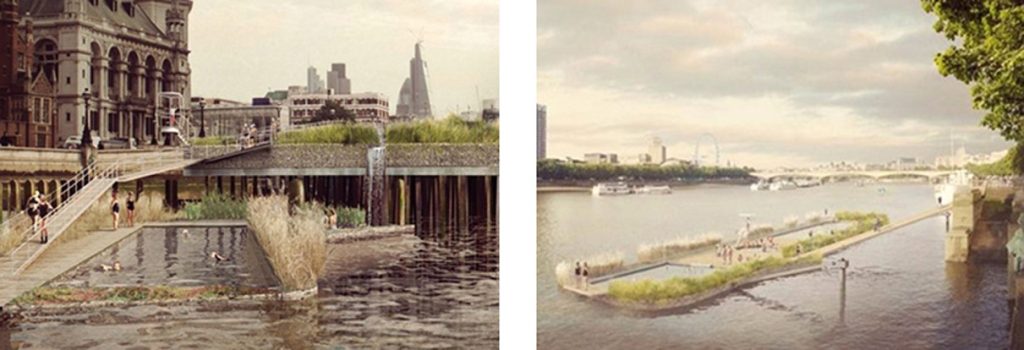
A crowd-funded Kickstarter campaign has commenced for the design and build of a freshwater swimming pool on the River Thames, London. The Baths hope to increase public utilisation of the river for recreational purposes and to bring a public swimming location to the middle of the city. The Baths will add to London’s number of growing riverside attractions.
The concept includes a floating pontoon that will rise and fall with the tide and provide an area of filtered, clean river water for swimmers. Water in the baths will be heated, providing a year-round swimming spot with a 25-metre pool for laps, as well as a training pool.
Read more about The River Thames.
Images: thamesbaths.com
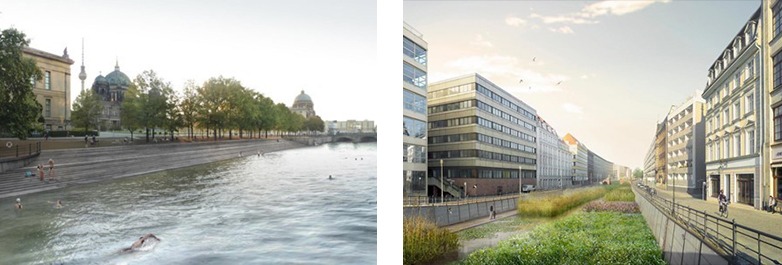
The Flussbad project seeks to transform the Spree Canal located in downtown Berlin into a public space for recreation and relaxation. Located between the Fischerinsel (Fischer Island) and Bode Museum, the Flussbad will split into two arms as it wraps around the UNESCO World Heritage area of Museum Island. The wider arm will service commercial use and boats, while the narrower arm will be redesigned and constructed for the purpose of pedestrian and recreational use.
The Flussbad urban planning initiative envisages turning a 1.8km stretch of water into a series of new riverside paths, swimming areas and landscaped parks. The plan is to filter water entering the canal in an ecologically sensitive manner mimicking wetlands by using natural plants, reeds and beds of gravel. A new bypass sewer will be also constructed to separate stormwater overflows and ensure that discharges are fed into the river’s main arm. The filtration system will provide clean, natural river water downstream suitable for swimming, with amenities and facilities built to encourage easy access and usage of the river.
An ambitious project, the Flussbad is supported by the German Federal Government, the City of Berlin, and several organisations, community groups and individuals.
Find out more about the Flussbad project.
Images: www.flussbad-berlin

